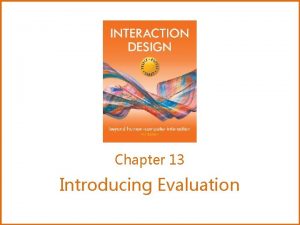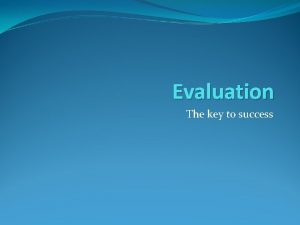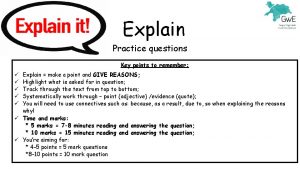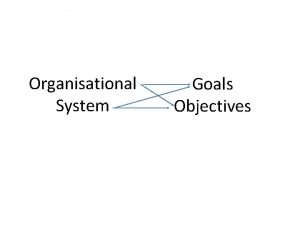Chapter 14 INTRODUCING EVALUATION Goals Explain the key






















- Slides: 22

Chapter 14 INTRODUCING EVALUATION

Goals • Explain the key concepts and terms used in evaluation • Introduce range of different types of evaluation methods • Show different evaluation methods are used for different purposes at different stages of the design process and in different contexts of use • Show evaluators mixed and modified to meet the demands of evaluating novel systems www. id-book. com 2

Goals (continued) • Discuss some of the practical challenges of doing evaluation • Through case studies, illustrate how methods discussed in Chapters 8, 9, and 10 are used in evaluation, and describe some methods that are specific to evaluation • Provide an overview of methods that are discussed in detail in the next two chapters www. id-book. com 3

Why, what, where, and when to evaluate Iterative design and evaluation is a continuous process that examines: Why: To check users’ requirements and confirm that users can utilize the product and that they like it What: A conceptual model, early and subsequent prototypes of a new system, more complete prototypes, and a prototype to compare with competitors’ products Where: In natural, in-the-wild, and laboratory settings When: Throughout design; finished products can be evaluated to collect information to inform new products www. id-book. com 4

Bruce Tognazzini tells you why you need to evaluate “Iterative design, with its repeating cycle of design and testing, is the only validated methodology in existence that will consistently produce successful results. If you don’t have user -testing as an integral part of your design process you are going to throw buckets of money down the drain. ” See Ask. Tog. com for topical discussions about design and evaluation www. id-book. com 5

Types of evaluation Controlled settings that directly involve users (for example, usability and research labs) • Natural settings involving users (for instance, online communities and products that are used in public places) § Often there is little or no control over what users do, especially in in-the-wild settings • Any setting that doesn’t directly involve users (for example, consultants and researchers critique the prototypes, and may predict and model how successful they will be when used by users www. id-book. com 6

Living labs • People’s use of technology in their everyday lives can be evaluated in living labs • Such evaluations are too difficult to do in a usability lab • An early example was the Aware Home that was embedded with a complex network of sensors and audio/video recording devices (Abowd et al. , 2000) www. id-book. com 7

Living labs (continued) • More recent examples include whole blocks and cities that house hundreds of people, for example, Verma et al. , research in Switzerland (2017) • Many citizen science projects can also be thought of as living labs, for instance, i. Naturalist. org • These examples illustrate how the concept of a lab is changing to include other spaces where people’s use of technology can be studied in realistic environments www. id-book. com 8

Evaluation case studies • A classic experimental investigation into the physiological responses of players of a computer game • An ethnographic study of visitors at the Royal Highland show in which participants are directed and tracked using a mobile phone app • Crowdsourcing in which the opinions and reactions of volunteers (for example, from the crowd) inform technology evaluation www. id-book. com 9

Challenge and engagement in a collaborative immersive game • Physiological measures were used • Players were more engaged when playing against another person than when playing against a computer • Why was the physiological data collected normalized? www. id-book. com 10

Physiological data of participants in a videogame Source: Mandryk and Inkpen (2004), “The Physiological Indicators for the Evaluation of Colocated Collaborative Play, ” CSCW’ 2004, pp 102 -111. Reproduced with permission of ACM Publications. www. id-book. com 11

Example of physiological data A participants’ skin response when scoring a goal against a friend (a), and another participants’ response when engaging in a hockey fight against a friend versus against the computer (b). Source: Mandryk and Inkpen (2004), “The Physiological Indicators for the Evaluation of Colocated Collaborative Play, ” CSCW’ 2004, pp 102 -111. Reproduced with permission of ACM Publications. www. id-book. com 12

Ethnobot app used at the Royal Highland Show • The Ethnobat directed Billy to a particular place (Aberdeenshire Village) • Next, Ethnobot asks “…what’s going on? ” • The screen shows five of the experience buttons from which Billy needs to select a response Source: Tallyn et al. (2018) Reproduced with permission of ACM Publications. www. id-book. com 13

Experience responses submitted in Ethnobot Number of prewritten experience responses submitted by participants to the pre-established questions that Ethnobot asked them about their experiences Source: Tallyn et al. (2018) Reproduced with permission of ACM Publications. www. id-book. com 14

What did we learn from the case studies? • How to observe users in the lab and in natural settings • How evaluators excerpt different levels of control in the lab and in natural settings and in crowdsourcing evaluation studies • Use of different evaluation methods www. id-book. com 15

What did we learn from the case studies? (continued) • How to develop different data collection and analysis techniques to evaluate user experience goals such as challenge and engagement • The ability to run experiments on the Internet that are quick and inexpensive using crowdsourcing • How a large number of participants can be recruited using Mechanical Turk www. id-book. com 16

Evaluation methods Method Controlled settings Natural settings Observing x x Asking users x x Asking experts Testing x Without users x x Modeling x www. id-book. com 17

The language of evaluation • • Analytics Analytical evaluation Biases Controlled experiment Crowdsourcing Ecological validity Expert review or criticism • Field study • Formative evaluation • Heuristic evaluation • • • Informed consent form In the wild evaluation Living laboratory Predictive evaluation Reliability Scope Summative evaluation Usability laboratory User studies Usability testing Users or participants Validity www. id-book. com 18

Participants’ rights and getting their consent • Participants need to be told why the evaluation is being done, what they will be asked to do and informed about their rights • Informed consent forms provide this information and act as a contract between participants and researchers • The design of the informed consent form, the evaluation process, data analysis, and data storage methods are typically approved by a high authority, such as the Institutional Review Board www. id-book. com 19

Things to consider when interpreting data Reliability: Does the method produce the same results on separate occasions? Validity: Does the method measure what it is intended to measure? Ecological validity: Does the environment of the evaluation distort the results? Biases: Are there biases that distort the results? Scope: How generalizable are the results? www. id-book. com 20

Summary • Evaluation and design are very closely integrated • Some of the same data gathering methods are used in evaluation as for establishing requirements and identifying users’ needs, for example, observation, interviews, and questionnaires • Evaluations can be done in controlled settings such as laboratories, less controlled field settings, or where users are not present www. id-book. com 21

Summary (continued) • Usability testing and experiments enable the evaluator to have a high level of control over what gets tested, whereas evaluators typically impose little or no control on participants in field studies • Different methods can be combined to get different perspectives • Participants need to be made aware of their rights • It is important not to over-generalize findings from an evaluation www. id-book. com 22
 Strategic goals tactical goals operational goals
Strategic goals tactical goals operational goals Strategic goals tactical goals operational goals
Strategic goals tactical goals operational goals Rowe concise introduction to linguistics download
Rowe concise introduction to linguistics download General goals and specific goals
General goals and specific goals Examples of generic goals and product-specific goals
Examples of generic goals and product-specific goals Introducing government in america chapter 1
Introducing government in america chapter 1 Operational definition in psychology
Operational definition in psychology Sensory evaluation the human factor
Sensory evaluation the human factor Tripadvisor business model canvas
Tripadvisor business model canvas Contoh bisnis model canvas makanan pdf
Contoh bisnis model canvas makanan pdf Signal words to introduce a quote
Signal words to introduce a quote 1941-1882
1941-1882 Quote analysis sentence starters
Quote analysis sentence starters What is a counterclaim in an argumentative essay
What is a counterclaim in an argumentative essay Unit 1 about myself
Unit 1 about myself How to introduce yourself in training session
How to introduce yourself in training session Ma
Ma Poetic devices
Poetic devices Introduction about digestive system
Introduction about digestive system Company profile of kfc
Company profile of kfc Integers essential questions
Integers essential questions Introducing internet
Introducing internet Sentence starters for embedding quotes
Sentence starters for embedding quotes











































